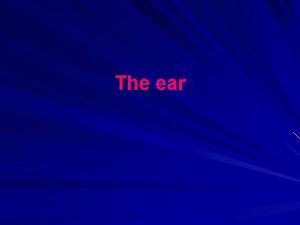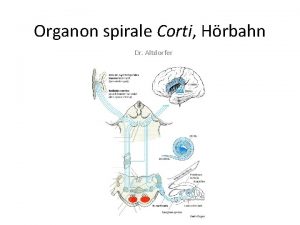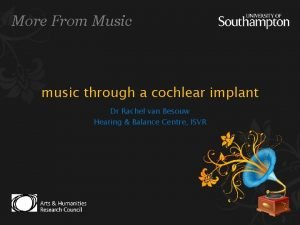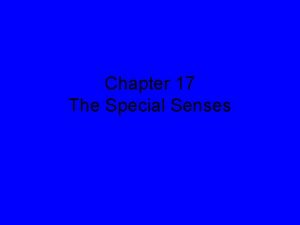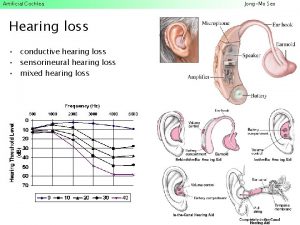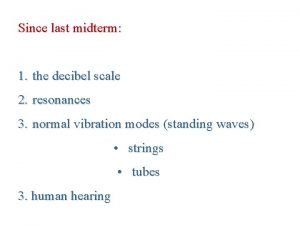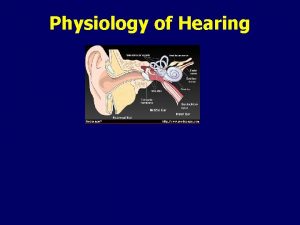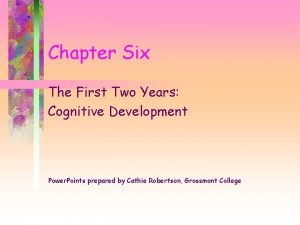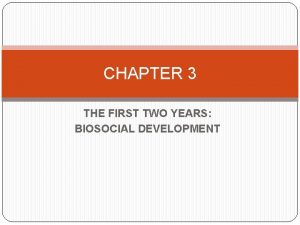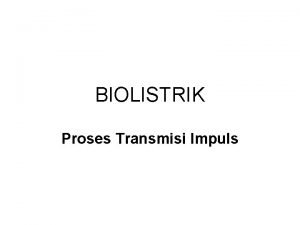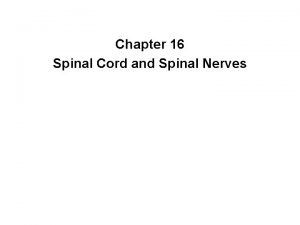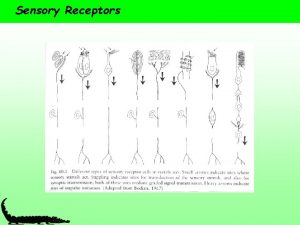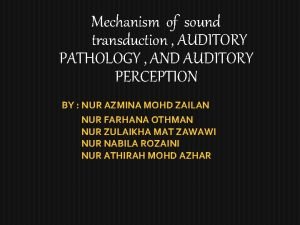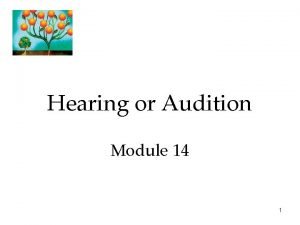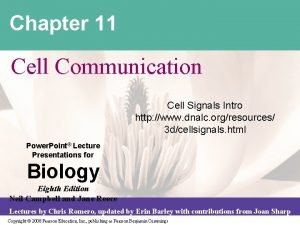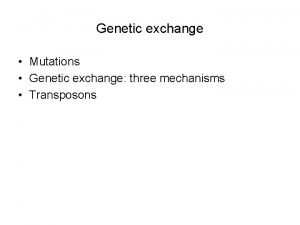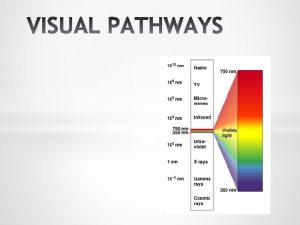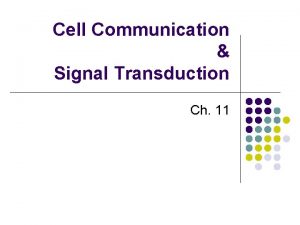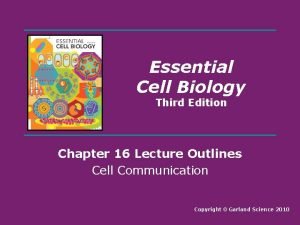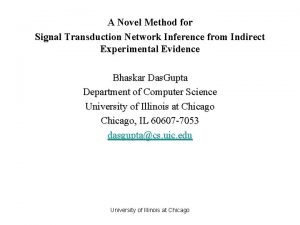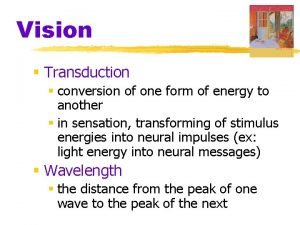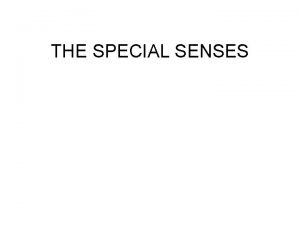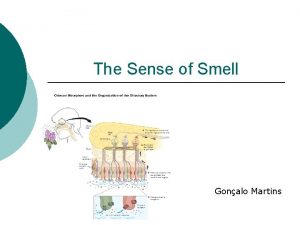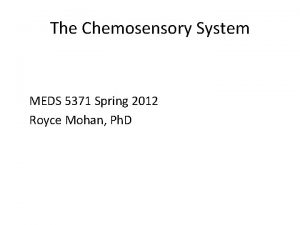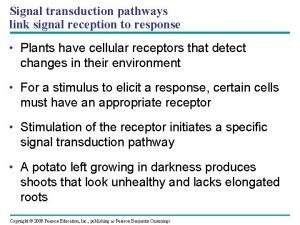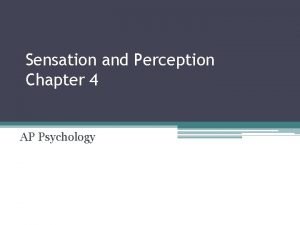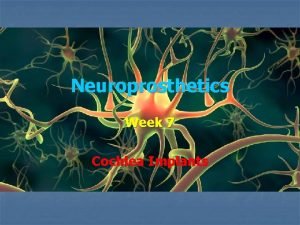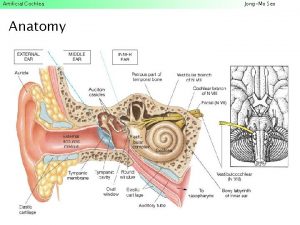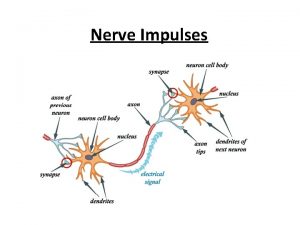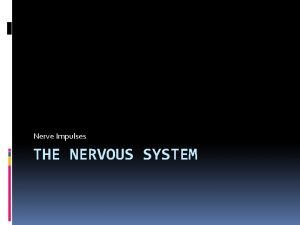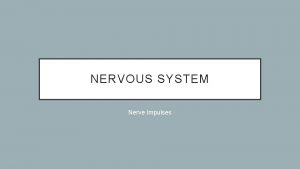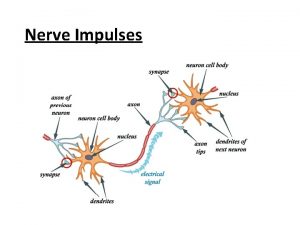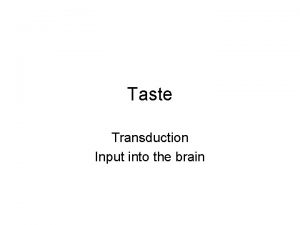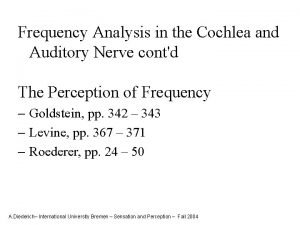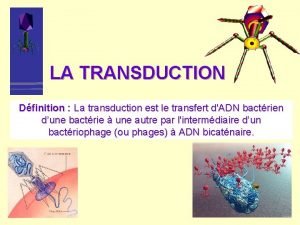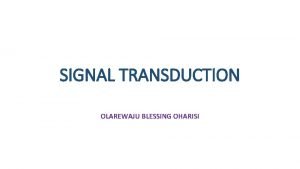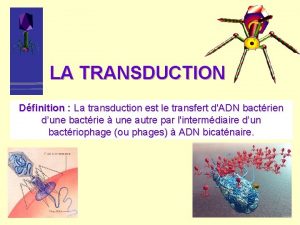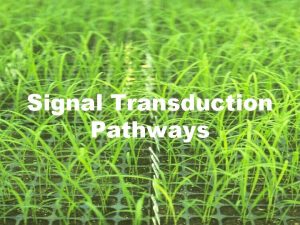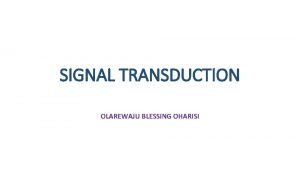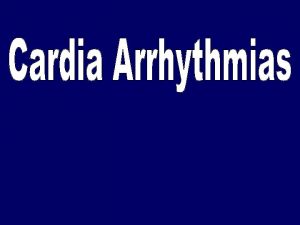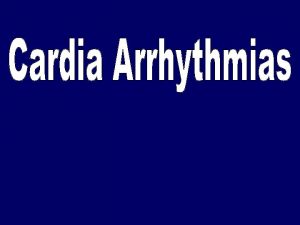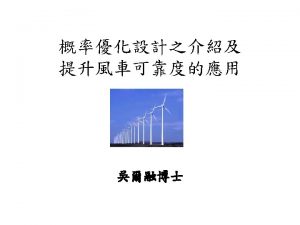The Cochlea Frequency analysis Transduction into neural impulses

































- Slides: 33

The Cochlea • Frequency analysis • Transduction into neural impulses

Auditory Pathways

Tuning • Frequency response is usually plotted as a tuning curve – at how loud does a tone at a specific frequency have to be to excite an auditory nerve fiber • Auditory nerve fibers are narrowly tuned at high frequencies and broadly tuned at low frequencies • Tonotopic map in cochlea – high frequenies at base and frequency decreases as go to apex

Volley Theory of Pitch Perception The number of action potentials every second along with the time interval between action potentials determines the frequency (pitch) of the sound we are listening to.

Hair cells and auditory nerve fibers • The thresholds of auditory nerve fibers vary regularly with low threshold fibers on the pillar side of the inner hair cell and high threshold fibers on the modiolar side. • The low threshold fibers have high spontaneous activity rates, while the high threshold fibers have low spontaneous activity rates. High spontaneous + low threshold Low Spontaneous + high threshold

Conclusions about auditory nerve fibers • Tuning: an auditory nerve fiber responds to a limited frequency range with fibers from the base tuned to high frequencies and fibers from the apex tuned to low frequencies (place theory of pitch perception). • Timing: auditory nerve fibers preserve temporal information at low frequencies (<4000 Hz) for pitch perception (volley theory) and for sound localization. • Threshold: auditory nerve fibers have different thresholds so that we can hear over a large intensity range while preserving timing information

Parts of the cochlear nucleus high middle low • The cochlear nucleus is divided into dorsal (DCN) high frequency and ventral (VCN) parts middle • The ventral cochlear frequency nucleus is divided by the low frequency auditory nerve into anterior (AVCN) and posterior (PVCN) divisions. • There is a tonotopic map in each subdivision.

Stellate Cells • Stellate cells have dendrites that run parallel to the path of auditory nerve fibers • Each stellate cell receives many inputs from only a few nerve fibers • A stellate cell responds only to a narrow band of frequencies

Stellate cells are linear • Stellate cells respond linearly to depolarizations and hyperpolarizations. • In response to depolarizing current, they produce a train of action potentials.

Stellate cells fire regularly in response to tones • The train of action potentials is very regular. • Stellate cells integrate information temporally (sum EPSPs) but not over a wide frequency range. • Stellate cells respond to tones with a “chopper” PST that reflects their regular firing pattern.

Bushy Cells • Spherical bushy cells (A) in anterior AVCN receive endbulbs of Held from only a couple of auditory nerve fibers (B, C, D). • Globular bushy cells in posterior AVCN receive multiple inputs from just a few auditory nerve fibers (E, F, G). • Each bushy cell responds only to a narrow band of frequencies

Bushy cells are nonlinear • Bushy cells are hard to depolarize. For long depolarizations they produce one or two action potentials. • Bushy cells are linear when hyperpolarized.

Bushy cells preserve temporal information • They do not integrate over time. Each auditory nerve input ( at | ) produces an EPSP, A&B, but there is no summation. • Bushy cells preserve the temporal characteristics of the auditory nerve input. Their peristimulus time (PST) histograms look like those of auditory nerve fibers, and are called Primary-like. • Temporal information needed for sound localization.

Octopus Cells in PVCN • Octopus cells have two or three large dendrites that extend perpendicularly across the paths of many auditory nerve fibers. • Octopus cells are ideally situated to integrate information across frequency.

Octopus cells are nonlinear • Like bushy cells octopus cells are hard to depolarize and produce only a single action potential. • Octopus cells are also hard to hyperpolarize

Octopus cells detect synchrony • Octopus cells respond to a tone with an “onset” PST histogram • Octopus cells are capable of firing very rapidly (1000 action potentials/second) • Octopus cells are activated by synchronous activity of many auditory nerve fibers generated by such stimuli as clicks.

Multipolar Cells • Multipolar cells have dendrites that extend across a large number of auditory nerve fibers. • Multipolar cells project to the DCN, the AVCN and to the cochlear nucleus on the other side of the brainstem.

Characteristics of Ventral Cochlear Nucleus Neurons Tuning Spherical Bushy cells Globular Bushy cells Stellate cells Multipolar Octopus cells Narrow Broad Nonlinear Linear Nonlinear Onset Chopper Onset Intrinsic Nonlinear Membrane Properties PST Primary-like Chopper Histogram with notch Function Preserve Loudness - Loudness timing integrate in – overall information critical band (AGC? ) Project to - Superior send info Olivary Complex Superior Olivary Complex * Inferior Colliculus Synchrony – integrate across freq. Cochlear Lateral nucleus on Lemniscus other side

Parts of the cochlear nucleus high middle low • The cochlear nucleus is divided into dorsal (DCN) high frequency and ventral (VCN) parts middle • The ventral cochlear frequency nucleus is divided by the low frequency auditory nerve into anterior (AVCN) and posterior (PVCN) divisions. • There is a tonotopic map in each subdivision.

Dorsal Cochlear Nucleus • The dorsal cochlear nucleus is a layered structure. • Outer layer is the molecular layer and contains axons of granule cells • Large fusiform cell layer • Deep DCN – contains auditory nerve axons and neurons

Molecular and Fusiform cell layers • Fusiform cells have two sets of dendrites – one set extends into the molecular layer perpendicular to the paths of granule cell axons, and the other set extends into the deep DCN to make contact with the axons of auditory nerve fibers. • Structure is similar to the cerebellum

Role of cells in fusiform and molecular layers • Layers only found in animals that can move their ears • Humans lack these layers • Granule cells receive inputs from somatosensory nuclei in the brainstem • Perpendicular arrangement of granule cell axon and fusiform cell dendrites cross-correlates ear position with auditory input cat human

Fusiform cells are nonlinear • Fusiform cells have complex, nonlinear characteristics similar to Purkinje cell in the cerebellum

Response properties of fusiform cells • Fusiform cells respond to tones with a “pauser-buildup” PST • They receive inhibition that shuts them off after the initial response. • Moving the pinna also greatly affects the response of fusiform cells

Tuberculoventral neurons • Tuberculoventral neurons in the deep layer of the DCN project to the VCN • They inhibit cells that receive inputs from the same auditory nerve fibers that innervate them – it is a frequency-specific inhibition • The inhibition is delayed • A delayed, frequencyspecific inhibition can suppress echoes

Characteristics of Dorsal Cochlear Nucleus Neurons Fusiform cells Granule cells Tuberculoventral neurons Tuning Narrow/broad sidebands ? Narrow Intrinsic Membrane Properties Nonlinear ? Nonlinear PST Histogram Pauser Buildup Function Compensate for motion of pinna Convey info Suppress echoes about position of pinna Project to send info Inferior Colliculus Molecular layer of DCN Many different shapes Ventral cochlear nucleus

Role of the cochlear nucleus • Spread information from an auditory nerve fiber onto multiple parallel ascending pathways • Extract specific features of the stimulus – Intensity in a critical band – Overall intensity – Synchrony across frequency • Process information to make subsequent analysis possible – Echo suppression • Compensate for position of external ear (if necessary)

Projections from the cochlear nucleus Bushy cells Cochlear Nucleus Octopus cells Superior Olivary Complex Stellate cells Fusiform cells Nuclei of the Lateral Lemniscus Tonotopic Inferior Colliculus Medial Geniculate Nucleus in Thalamus Non-tonotopic


Bushy Cell to Lateral Superior Olive Projection

LSO processes intensity differences • LSO neurons respond mostly to high frequencies • Excited by sound at the ipsilateral ear (from spherical bushy cells) • Inhibited by sound at the contralateral ear (from globular bushy cells via MNTB)

MSO processes timing differences Delay lines • • • MSO responds mostly to low frequency sounds Cells in the MSO are coincidence detectors Input from the opposite side is delayed MSO cells respond at specific interaural time difference (ITD) Center to ear encoded from front to back in MSO

Descending pathway (efferents) • Two pathways project from the SOC to the cochlea – Medial system (around MSO) – large, myelinated fibers – Lateral system (around LSO) – thin, unmyelinated fibers
 Incoming sensory impulses and outgoing motor impulses
Incoming sensory impulses and outgoing motor impulses Tympanic cavity
Tympanic cavity Pfeilerzellen
Pfeilerzellen Artificial cochlea
Artificial cochlea Cochlea
Cochlea Cochlea
Cochlea Cochlea
Cochlea Scala tympani scala vestibuli
Scala tympani scala vestibuli Social impulses foster infant language
Social impulses foster infant language Social impulses foster infant language
Social impulses foster infant language Transmisi impuls saraf
Transmisi impuls saraf Transmits nerve impulses
Transmits nerve impulses Transmits nerve impulses
Transmits nerve impulses Striate cortex
Striate cortex Types of thermoreceptors
Types of thermoreceptors Cell communication pogil
Cell communication pogil Transduction in the ear
Transduction in the ear Where does transduction occur in the ear
Where does transduction occur in the ear Transduction in the ear
Transduction in the ear Chapter 11 cell communication
Chapter 11 cell communication Generalized transduction
Generalized transduction Lateral geniculate nucleus
Lateral geniculate nucleus Transduction cognitive psychology
Transduction cognitive psychology Cell signal transduction
Cell signal transduction Essential cell biology chapter 3 quiz
Essential cell biology chapter 3 quiz Signal transduction
Signal transduction Transduction psychology
Transduction psychology Olfactory transduction
Olfactory transduction Olfactory transduction
Olfactory transduction Olfactory transduction
Olfactory transduction Signal transduction
Signal transduction What are phytochromes
What are phytochromes Do subliminals really work
Do subliminals really work Olfactory transduction
Olfactory transduction

